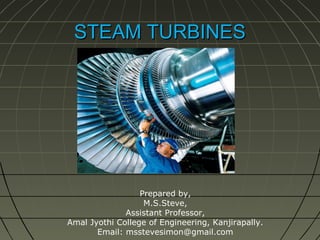
STEAM TURBINES EXPLAINED
- 1. STEAM TURBINES Prepared by, M.S.Steve, Assistant Professor, Amal Jyothi College of Engineering, Kanjirapally. Email: msstevesimon@gmail.com
- 2. Steam Turbines “Steam Turbine is a prime-mover in which Pressure energy of steam is transformed into Kinetic energy, and later in its turn is transformed into the mechanical energy of rotation of turbine shaft” msstevesimon@gmail.com
- 3. Classification based on Principle of Action 1.Impulse Turbine Pressure energy of Steam is converted into Kinetic Energy. Impulse action of high velocity jet of steam, due to change in its direction is used to rotate the turbine shaft. 2.Reaction Turbine Reaction force due to expansion of high pressure steam when it passes through a set of moving and fixed blades is used to rotate the turbine shaft. Due to expansion of steam, pressure drop occurs continuously over both fixed and moving blades. This pressure difference exerts a thrust on the blades. The resulting reaction force imparts rotary motion. msstevesimon@gmail.com
- 4. msstevesimon@gmail.com Impulse Turbine 1. 2. 3. 4. 5. Casing Nozzle – Pressure energy of Steam is converted into Kinetic Energy Turbine Blade – Convert kinetic energy into mechanical work. Rotor Shaft
- 5. Impulse turbine - Working High pressure steam from boiler is supplied to fixed nozzles. Nozzle – Pressure falls from boiler pressure to condenser pressure Reduction in pressure increases velocity. High velocity steam impinges on moving curved vanes Causes change in momentum Impulsive force on blades. Pressure remains constant when steam flows through blades. Eg: De Lavel Turbine msstevesimon@gmail.com
- 7. Disadvantages of Impulse Turbine The velocity of Rotor is too high for practical purpose The velocity of steam leaving the turbine is considerably high and hence there is a loss in Kinetic Energy These problems can be overcome by expanding the steam in different stages. This is known as Compounding. msstevesimon@gmail.com
- 8. Reaction Turbine 1. 2. • • 3. 4. 5. Casing Fixed Blades Performs the function of Nozzle in Impulse turbine. It directs steam to adjacent moving blade. Moving Blades Shaft Rotor msstevesimon@gmail.com
- 9. msstevesimon@gmail.com Working High pressure steam directly supplied to turbine blades with out nozzles. Steam expands(diameter increases) as it flows through fixed and moving blades Continuous drop of pressure. Produces reaction on blades Reaction causes rotor to rotate. Propulsive force causing rotation of turbine is the reaction force. Hence called reaction turbine. Eg: Parson’s Turbine
- 11. Compounding of Impulse Turbine The extreme high speed of Impulse Turbine of the order of 30,000rpm, cannot be directly used for practical purpose. To reduce the speed more than one set of blades are used. This is called compounding. There are three types of compounding Velocity Compounding Pressure Compounding Pressure – Velocity Compounding msstevesimon@gmail.com
- 12. Velocity Compounding .. 1 1. 2. 3. 4. 5. Nozzle Moving Blades Fixed Blades Rotor Shaft msstevesimon@gmail.com
- 13. Velocity Compounding .. 2 • • • • Velocity of steam absorbed in stages Moving and fixed blades placed alternatively. Entire pressure drop takes place in nozzle. Kinetic energy of steam converted into mechanical work in 2 stages in figure msstevesimon@gmail.com
- 14. Velocity Compounding .. 3 • • • • Velocity reduced to intermediate velocity in the 1st row of moving blades Fixed blade direct steam to 2nd set of moving blades. Velocity further reduced in 2nd set of moving blades Eg: Curtis Turbine msstevesimon@gmail.com
- 17. Pressure Compounding ..2 • • • • Pressure energy of steam absorbed in stages. Expansion of steam takes place in more than one set of nozzles Nozzles followed by set of moving blades Pressure energy of steam converted into kinetic energy in nozzles msstevesimon@gmail.com
- 18. Pressure Compounding ..3 • • Kinetic energy transformed to mechanical work in moving blades. No change in pressure in blades. msstevesimon@gmail.com
- 20. Pressure Velocity Compounding..1 Combination of pressure compounding and velocity compounding. In a 2 stage pressure velocity compounded turbine – total drop in steam pressure carried out in 2 stages. Velocity obtained in each stage is compounded. msstevesimon@gmail.com
- 22. Pressure Velocity Compounding..3 1st stage and 2nd stage taken separately are identical to velocity compounded turbine. Combines advantages of pressure and velocity compounding. msstevesimon@gmail.com
- 27. Thank you…!
